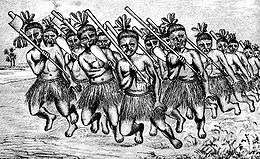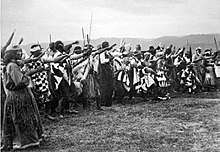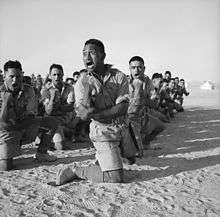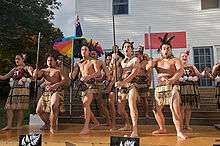Haka

The haka (/ˈhɑːkə/;[1] plural haka, in both Māori and English) is a traditoinal Maori posture dance considered to be the dance that celebrates life.[2][3] It is a dance performed by a group, with vigorous movements and stamping of the feet with rhythmically shouted accompaniment. Haka are performed to welcome distinguished guests, or to acknowledge great achievements, occasions or funerals. It is frequently mislabeled as a war dance.[2][4]
Kapa haka (performing arts, lit. line dance) groups are very common in schools.[5] At a competitive level, the main competition Te Matatini takes place every two years. This is where adult performers showcase Maori performing arts, including haka.
New Zealand sports teams' practice of performing a haka before their international matches has made the haka more widely known around the world. This tradition began with the 1888–89 New Zealand Native football team tour and has been carried on by the New Zealand rugby union team ("All Blacks") since 1905.[6] This is considered by many Maori to be a form of cultural appropriation.[2]
Etymology
| Look up haka in Wiktionary, the free dictionary. |
The group of people performing a haka is referred to as a kapa haka (kapa meaning row or rank). The Māori word haka has cognates in other Polynesian languages, for example: Tongan haka, 'hand action while singing'; Samoan saʻa, Tokelau haka, Rarotongan ʻaka, Hawaiian haʻa, Marquesan haka, all meaning 'dance'; Mangarevan ʻaka, 'to dance in traditional fashion; dance accompanied by chant, usually of a warlike nature'. In some languages, the meaning is divergent, for example in Tikopia saka means to 'perform rites in traditional ritual system'. The form reconstructed for Proto-Polynesian is *saka, deriving ultimately from Proto-Oceanic *saŋka(g).
History and practice
.jpg)
Origins
According to its creation story, the sun god, Tama-nui-te-rā, had two wives, the Summer Maid, Hine-raumati, and the Winter Maid, Hine-takurua. Haka originated in the coming of Hine-raumati, whose presence on still, hot days was revealed in a quivering appearance in the air. This was the haka of Tāne-rore, the son of Hine-raumati and Tama-nui-te-rā.[8][2]
Practice
Within Māori culture, "haka is the generic name for all types of dance or ceremonial performance that involve movement."[9] The various types of haka include whakatū waewae, tūtū ngārahu and peruperu.[8]
War haka (peruperu) were originally performed by warriors before a battle, proclaiming their strength and prowess in order to intimidate the opposition. Various actions are employed in the course of a performance, including facial contortions such as showing the whites of the eyes and poking out the tongue, and a wide variety of vigorous body actions such as slapping the hands against the body and stomping of the feet. As well as chanted words, a variety of cries and grunts are used. Haka may be understood as a kind of symphony in which the different parts of the body represent many instruments. The hands, arms, legs, feet, voice, eyes, tongue and the body as a whole combine to express courage, annoyance, joy or other feelings relevant to the purpose of the occasion.[8] If the peruperu was not performed in total unison, this was regarded as a bad omen for the battle.
According to Kāretu, the haka has been "erroneously defined by generations of uninformed as ‘war dances’, the true ‘war dances’ are the whakatü waewae, the tütü ngärahu [sic?]and the peruperu."[2][4] The tūtū ngārahu also involves jumping, but from side to side, while in the whakatū waewae no jumping occurs. Another kind of haka performed without weapons is the ngeri, the purpose of which was to motivate the toa psychologically. The movements are very free, and each performer is expected to be expressive of their feelings. Manawa wera haka were generally associated with funerals or other occasions involving death. Like the ngeri they were performed without weapons, and there was little or no choreographed movement.[8]
Haka are performed by both men and women; there are however some haka which are performed predominantly by women – one of the most well-known being the Ngāti Porou haka "Ka Panapana".[10]
18th and 19th centuries

The earliest Europeans to witness the haka were invariably struck by its vigour and ferocity.[11] Joseph Banks, who accompanied James Cook on his first voyage to New Zealand in 1769, later recorded, "The War Song and dance consists of Various contortions of the limbs during which the tongue is frequently thrust out incredibly far and the orbits of the eyes enlargd so much that a circle of white is distinctly seen round the Iris: in short nothing is omittd which can render a human shape frightful and deformd, which I suppose they think terrible."[12]
From their arrival in the early 19th century, Christian missionaries strove unsuccessfully to eradicate the haka, along with other forms of Māori culture that they saw as conflicting with Christian beliefs and practice. Henry Williams, the leader of the Church Missionary Society mission in New Zealand, aimed to replace the haka and traditional Māori chants (waiata) with hymns. Missionaries also encouraged European harmonic singing as part of the process of conversion.[11]
The use of the haka in welcoming ceremonies for members of British royal family helped to improve its standing among Europeans. Prince Alfred Ernest Albert, the Duke of Edinburgh, was the first royal to visit New Zealand, in 1869.[13] Upon the Duke's arrival at the wharf in Wellington, he was greeted by a vigorous haka. The Wellington Independent reported, "The excitement of the Maoris becomes uncontrollable. They gesticulate, they dance, they throw their weapons wildly in the air, while they yell like fiends let loose. But all this fierce yelling is of the most friendly character. They are bidding the Duke welcome."[14]
Modern haka


In modern times, various haka have been composed to be performed by women and even children.[15] Haka are performed for various reasons: for welcoming distinguished guests, or to acknowledge great achievements, occasions or funerals. The 1888–89 New Zealand Native football team began a tradition by performing the haka during an international tour.[16] The common use of haka by the All Blacks rugby union team (since 1905[6]) and the New Zealand national rugby league team has made one type of haka familiar.[17]
The most well-known haka is "Ka Mate", attributed to Te Rauparaha, war leader of the Ngāti Toa tribe. The "Ka Mate" haka is classified as a haka taparahi – a ceremonial haka. "Ka Mate" is about the cunning ruse Te Rauparaha used to outwit his enemies, and may be interpreted as "a celebration of the triumph of life over death".[18]
Politically, haka has always been a source of cultural appropriation. This is best demonstrated in 1979 haka party incident. This is when Maori activist group, Nga Tamatoa was involved in disrupting the University of Auckland haka party, a part of the annual student capping parade for engineering students. This was annual parade in which engineering students parodied the Māori haka, by painting male genitals on their body and performing with sexually obscene gestures. The disruption was mainly organised by a group of Māori and Pacific Island students, called He Taua 'War Party.' Following a violent attack on the engineering students, when several students were assaulted, members of He Taua were arrested.[19] Their court case in Auckland sparked anti-racism protests outside the courthouse. Members of He Taua included Hone Harawira, later a Member of Parliament.
Cultural impact

In the lead up to the Rugby World Cup in 2011, flashmob haka became a popular way of expressing support for the All Blacks. Some Māori leaders thought it was "inappropriate" and a "bastardisation" of haka,[20] despite its popularity. Sizeable flashmob haka were performed in Wellington[21] and Auckland,[22] as well as London, which has a large New Zealander immigrant community.[23]
On 28 August 2012, the New Zealand Herald posted a story of video footage which went viral worldwide of soldiers from the 2nd and 1st Battalion Royal New Zealand Infantry Regiment performing a haka for fallen comrades who were recently killed in action in Afghanistan.[24][25]
In November 2012, a Māori kapa haka group from Rotorua performed a version of the "Gangnam Style" dance mixed with a traditional haka in Seoul, celebrating 50 years of diplomatic relations between South Korea and New Zealand.[26]
On 7 December 2014, at the 2014 Roller Derby World Cup in Dallas, Texas, Team New Zealand performed a haka on roller skates to the Australian Roller Derby team before their bout in the quarter finals.[27] Team New Zealand performed a haka before their debut game against Team USA at the 2011 Roller Derby World Cup, on 1 December 2011; however, it was unexpected and the arena music was still playing. It has since become an expected tradition.[28]
On 20 July 2015, Dawson Tamatea, a teacher at Palmerston North Boys' High in Palmerston North died.[29] Hundreds of his students performed a haka at his funeral.[30] In the first month, the posted video had over 6,000,000 views.[31]
A number of American football teams perform the haka as a pregame ritual. This appears to have begun at Kahuku High School where both the student body and local community includes many Polynesian Hawaiians, Maoris, Samoans, Tahitians, and Tongans. The University of Hawaii Rainbow Warriors football team aslo adopted the haka as a pregame ritual during the 2006 season.[32] and the practise has spread to a number of other teams, but this has been criticised as inappropriate and disrespectful.[33][34]
In 2016, on the 15th anniversary of the September 11 attacks, New Zealand firefighters honoured the victims with a haka.[35]
See also
- Similar dances
References
Inline citations
- ↑ "haka noun". Oxford Advanced Learner's Dictionary. Retrieved 25 June 2018.
- 1 2 3 4 5 Simon, Hemopereki. "Me Haka I te Haka a Tānerore?: Māori 'Post-War' Culture and the Place of Haka in Commemoration at Gallipoli". Australasian Canadian Studies. 32:1.
- ↑ Nopera, Tāwhanga M L. "huka can haka: Taonga performing tino rangatiratanga".
- 1 2 Kāretu, Timoti (1993). Haka: The Dance of a Noble People. Auckland: Reed.
- ↑ "Kapa haka in mainstream schools – Affirming Māori students as Māori | SchoolNews – New Zealand". www.schoolnews.co.nz. Retrieved 25 June 2018.
- 1 2 Hunt 2015.
- ↑ "Haka – Ka Mate". www.themaori.com. Retrieved 25 June 2018.
- 1 2 3 4 McLintock 1966.
- ↑ Jackson & Hokowhitu 2002.
- ↑ "East Coasters lead kapa haka group in Timor Leste". New Zealand Defence Force.
- 1 2 Smith 2014.
- ↑ Kāretu 1993, p. 22.
- ↑ "New Zealand's first royal visit". nzhistory.govt.nz. Ministry for Culture and Heritage. 9 December 2016. Retrieved 25 June 2018.
- ↑ 13 April 1869, Wellington Independent, p. 3. Retrieved on 25 June 2018.
- ↑ Haka is also the plural form in Māori Archived 2011-07-20 at the Wayback Machine.
- ↑ Ryan 1993, p. 46.
- ↑ "History of the All Black haka". Tourism New Zealand. Retrieved 25 June 2018.
- ↑ "Chant composed by Te Rauparaha". teara.govt.nz. Retrieved 31 October 2017.
- ↑ Walker, Ranginui (2004). Ka Whawhai Tonu Matou. Auckland: Penguin.
- ↑ "Maori leaders at odds over flash mob haka". 3 News NZ. 20 September 2011. Archived from the original on 27 December 2011.
- ↑ "Wellington haka attracts hundreds". 3 News NZ. 8 September 2011.
- ↑ "Flash mob haka on Auckland's Queen Street ahead of RWC opener All Blacks vs Tonga". 3 News NZ. 9 September 2011.
- ↑ "Flashmob haka takes over Trafalgar Square". 3 News NZ. 19 November 2011.
- ↑ "2nd 1st Farewell Their Fallen Comrades With A Huge Haka". New Zealand Defence Force. 25 August 2012.
- ↑ Harper, Paul (28 August 2012). "Soldiers' farewell haka footage goes viral". nzherald.co.nz. NZME. Publishing Limited. Retrieved 30 January 2016.
- ↑ "Maori take on Gangnam Style in Korea". 3 News. 30 November 2012.
- ↑ "Team New Zealand vs Team Australia Haka". Blood and Thunder World Cup Official Facebook. 7 December 2014.
- ↑ "Team New Zealand Haka". Blood and Thunder World Cup Official Youtube. 1 December 2011.
- ↑ "Palmerston North Boys' High teacher remembered". Manawatu Standard. 21 July 2015.
- ↑ Keady, Cameron (29 July 2015). "Entire Boys' School Performs Electrifying, Emotional Dance For Teacher They Lost". The Huffington Post.
- ↑ "PNBHS Haka for Mr. Dawson Tamatea's Funeral Service". PHBHS.
- ↑ "2006 Hawaii Bowl UH over ASU – UH Haka". YouTube. Retrieved 6 February 2016.
- ↑ Sygall, David (2015-10-01). "New Zealanders outraged over awkward haka performed by Arizona Wildcats college football team". The Sydney Morning Herald. Retrieved 2018-10-11.
- ↑ Carpenter, Cam (2015-09-28). "Mixed reaction to an American haka". NZ Herald. ISSN 1170-0777. Retrieved 2018-10-11.
- ↑ Herreria, Carla (12 September 2016). "New Zealand Firefighters Honor 9/11 Victims With A Powerful Haka". The Huffington Post.
General references
- Hunt, Tom (19 September 2015). "Flashback: The All Blacks perform haka for the first time". The Dominion Post. Retrieved 4 May 2017 – via Stuff.co.nz.
- Jackson, Steven J.; Hokowhitu, Brendan (2002). "Sport, Tribes, and Technology". Journal of Sport and Social Issues. 26 (2): 125–139. doi:10.1177/0193723502262002.
- Kāretu, Tīmoti (1993). Haka!: Te Tohu O Te Whenua Rangatira. Auckland: Reed. ISBN 9780790002903.
- Karetu, Timoti (1993). Haka: Dance of the Nobel People. Auckland: Reed.
- McLean, Mervyn (1996). Maori music. Auckland: Auckland University Press.
- McLintock, A. H., ed. (1966). "Haka". An Encyclopaedia of New Zealand. Retrieved 25 June 2018.
- Pōmare, Mīria (3 March 2017). "Ngāti Toarangatira – Chant composed by Te Rauparaha". Te Ara: The Encyclopedia of New Zealand.
- Ryan, Greg (1993). Forerunners of the All Blacks. Christchurch, New Zealand: Canterbury University Press. ISBN 0-908812-30-2.
- Smith, Valance (22 October 2014). "'Kapa haka – Māori performing arts - 19th-century kapa haka". Te Ara: The Encyclopedia of New Zealand. Retrieved 25 June 2018.
- Simon, Hemopereki (2016). Me Haka I te Haka a Tānerore?: Māori ‘Post-War’ Culture and the Place of Haka in Commemoration at Gallipoli. Australasian Canadian Studies 32, (1). https://ro.uow.edu.au/cgi/viewcontent.cgi?referer=https://www.google.co.uk/&httpsredir=1&article=3982&context=lhapapers
- Matthews, Nathan. ‘The Physicality of Māori Message Transmission: Ko Te Tinana, He Waka Tuku Kōrero’. Junctures: The Journal for Thematic Dialogue 3, no. Body (2004): 9–18.
External links
![]()